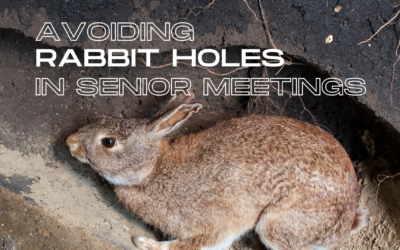When trying to work out if your communication is any good or not, do you wonder what is the most important measure of success?
I have an unusual take on it.
When it comes to important papers, my hunch is that the single most important needle to move is the amount of time you and your colleagues spend reworking them.
If there is little rework, then they are fit for purpose. If there is much, it’s not a good sign for anyone.
That single measure may be enough. You may, however, like to dig a little deeper.
This week I’d like to offer the first of three measures you can use. Let me give you a preview and then dive into today’s topic: Clarity.
- Clarity – Can you glean the core messages within 30 seconds of opening a paper or presentation?
- Quality – How valuable are the insights?
- Velocity – How quickly can your team develop and deliver powerful insights that lead to better decisions?
Let me now dig into the first of these. Can you glean the core messages within 30 seconds of opening a paper or presentation?
This is where we ask whether the communication misses the mark. Are you
- Writing Agatha Christie reports that leave the big idea until the end
- Asking your decision makers to conduct Easter Egg Hunts to find the insights or
- Delivering papers that are either wafer thin or worse. They miss the point altogether.
We ask how well the messages jump off the page (or out of the mouth) so that your audience can grasp them quickly. How easy are they to find in the paper, presentation, discussion, email or other communication form?
Clarity helps us quickly see what the message is and check whether it does what is needed.
As one board director suggested recently, she would rather read papers that did not require him to conduct an Easter egg hunt. She does not enjoy hunting around ‘the garden’ of the paper to find where the insights are hidden.
She wants them to pop off the page so she can quickly skim the paper to decide how to read it.
Try asking how often a reader can glean the message within 30 seconds of opening the paper. You can also apply this to emails and other communication too.
While clarity is critical, though, it’s not enough. To quote one of my ‘crustier’ clients, the head of credit risk at a large bank:
“The team can now craft much clearer messages, which is very useful. But how do we stop them putting ‘rubbish’ in the boxes?”.
This leads me to my next dimension: quality of insight, which I’ll dive into next week.
Cheers,
Davina
RELATED POSTS
When to avoid reviewing other people's papers and presentations
Most of us review communication for colleagues....
How to be human when communicating with senior leaders
A couple of situations this week reminded me of...
How to deliver better board and SLT papers more quickly
TLDR ..... 1. Thank you for the LinkedIn...
Is your paper really for noting?
Hello Davina, TLDR .....1. Thank you for the...
How to keep your board on topic
How to keep your board on topic Has this...
How to build trust with senior leaders
TLDR: The answer is to provide less information...

PRESENTED BY DAVINA STANLEY
I love what I do.
I help senior leaders and their teams prepare high-quality papers and presentations in a fraction of the time.
This involves 'nailing' the message that will quickly engage decision makers in the required outcome.
I leverage 25+ years' experience including
- learning structured thinking techniques at McKinsey in Hong Kong in the mid 1990s before coaching and training their teams globally as a freelancer for a further 15 years
- being approved to teach the Pyramid Principle by Barbara Minto in 2009
- helping CEOs, C-suite leaders and their reports deeply understand their stakeholder needs and communicate accordingly
- seeing leaders cut the number of times they review major papers by ~30% and teams cut the amount of time they take to prepare major papers by ~20%*
- watching senior meetings focus on substantive discussions and better decisions rather than trying to clarify the issue
My approach helps anyone who needs to engage senior leaders and Boards.
Recent clients include 7Eleven, KPMG, Mercer, Meta, Woolworths.
Learn more at www.clarityfirstprogram.com
(*) Numbers are based on 2023 client benchmarking results.








